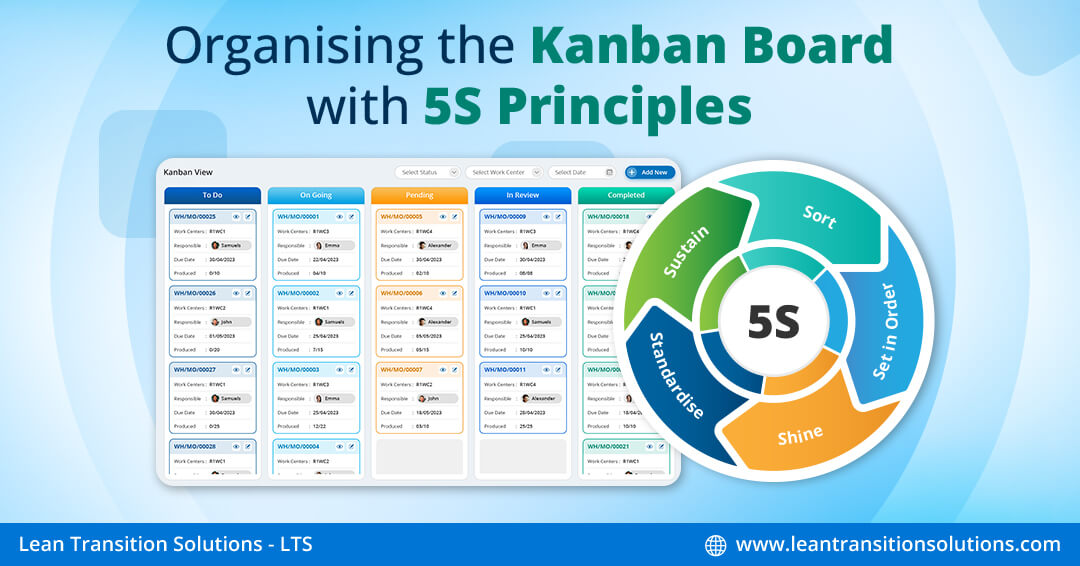Organising the Kanban Board with 5S Principles
April 10, 2024
Imagine a shop floor where every tool has its designated place, every step of the production process flows seamlessly, and efficiency is at its peak. Such an organised workspace isn't just a dream for manufacturers but a necessity for effective workflow management. You may know that the 5S system can declutter your workplace to provide enhanced clarity in your shop floor processes. - Yeah! It follows the mantra "a place for everything and everything in its place."
The Lean 5S methodology plays a key role in industries worldwide as it can streamline operations, reduce waste, and boost productivity. But what if organisations integrate the 5S method with a digital Kanban board?
Kanban integration with the 5S methodology streamlines workflow by organising tasks (Sort), optimising workspace (Set in order), maintaining cleanliness (Shine), standardising processes (Standardise), and sustaining improvements (Sustain), enhancing efficiency and productivity within the organisation.
Kanban view, renowned for facilitating efficient task management, becomes even more dynamic when integrated with the discipline of 5S principles. Let's check this in detail.
5S in Lean Management
The 5s lean management is a cornerstone for workplace organisation and efficiency. 5S Lean focuses on the 5S principles- Sort, Set in Order, Shine, Standardise, and Sustain.
Utilising a checklist facilitates adopting and supervising the lean management 5S. Typically, a 5S checklist comprises items or zones to be observed, evaluated, and graded based on their alignment with 5S principles. The 5S Audit Checklist assists auditors in assessing workspace efficiency and pinpointing improvement opportunities, streamlining the 5S system in manufacturing effectively. If you are ready to implement 5S Auditing Software or a 5S board in your organisation, you can carry out an effective 5’S lean program without hassle.
Getting to know the 5S Pillars
Sort: Sorting removes unnecessary items from the workplace and keeps only essential items. It enhances efficiency by decluttering the workplace and eliminating waste, allowing employees to find what they need quickly.
Set in Order: When items are arranged logically and efficiently, they reduce search time and improve workflow. For example, tools and materials stored in designated locations with clear labels are easier to find and use when necessary. Floor markings indicating loading areas and hazardous areas include other relevant examples.
Shine: Shine emphasises the importance of cleanliness and maintenance or 5s of workplace. Regular cleaning and upkeep prevent equipment breakdowns and maintain a safe and sound work environment for employees.
Standardise: Standardisation establishes uniform procedures, processes and practices throughout the organisation, ensuring consistency and reducing variability. Having Standardised Operating Procedures (SOPs) can increase the efficiency and quality of your workplace.
Sustain: Sustain focuses on maintaining the gains achieved through the previous steps of 5S over the long term. It involves conducting 5S audits and routine checks to ensure continuous improvement and adherence to five s principles. A 5S audit checklist ensures 5S standards and protocols are met and helps in sustaining the 5S process.
Safety: Nothing is perfect without ensuring Safety. A safe workplace with Standard Operating Procedures (SOPs) enhances the confidence of your workers and minimises the possibility of risks and accidents. Often, a Sixth "S" is integrated into 5S principles to form 6S, prioritising workplace safety along with efficiency.
What should you expect while integrating 5S Methodology with Kanban Boards?
Integrating the 5S Methodology with the Kanban system yields a synergistic approach that enhances workplace organisation and efficiency. By combining the systematic principles of 5S in manufacturing, focused on sorting, setting in order, shining, standardising, and sustaining, with the visual management and workflow optimisation of Kanban boards, teams can expect streamlined processes, reduced waste, and improved productivity. Kanban boards provide real-time visibility into work status, while 5S principles ensure a clean, organised, standardised workspace where smooth operational processes can be carried out. This integration fosters continuous improvement and empowers teams to deliver high-quality products efficiently and on time.
How to implement 5S on your Kanban Board?
Implementing 5S in your Kanban board involves a systematic approach that optimises workflow and enhances task visibility.
Sort
Eliminate unnecessary tasks or items cluttering your digital Kanban board through Kanban planning, ensuring only essential tasks remain visible.
Categorise tasks based on priority, using labels or colour-coding for clear identification or for establishing visual clarity.
Set in Order
Arrange tasks using Kanban cards in your digital Kanban board logically to ensure a smooth progression of operations from start to finish.
To indicate the task status, move the Kanban card representing the task from the “To Do” or “Ready To Start” column to “In Progress” and “Done” as the task progresses.
Utilise Kanban columns or swimlanes to segregate tasks based on stages, categories, or team members, enhancing visibility and task organisation.
Shine
Maintain cleanliness and organisation on your Kanban board by regularly removing outdated or irrelevant Kanban cards, ensuring a streamlined and focused kanban workflow.
Verify that Kanban cards representing tasks are appropriately placed within their respective columns and ensure that upcoming tasks are prepared and placed in the backlog column.
Update and maintain task information consistently to keep the Kanban board accurate and actionable, using Kanban cards efficiently.
Standardise
Establish clear guidelines and protocols for updating and utilising the Kanban board, promoting consistency and collaboration across team workflows.
Ensure uniformity in task management practices to promote efficiency and minimise confusion.
Sustain
Foster continuous improvement culture and adherence to 5S principles within the team, promoting ongoing optimisation of the Kanban Board.
Review and refine your 5S process regularly, utilising feedback and supporting data to maintain efficiency and effectiveness over time and sustain productivity on your shop floor.
Benefits of incorporating 5S principles on a Kanban Board
Enhanced Organisation: When 5S principles are integrated into a Kanban project management board, it ensures a structured workflow for your visual workplace, enhancing task identification and accessibility for better workflow management, thus boosting shop floor efficiency and productivity.
Reduced Waste: Eliminating unnecessary tasks maintains a clutter-free Kanban board, minimising waste and optimising resource utilisation, allowing focus on priority tasks for improved efficiency.
Improved Visibility: Clear task categorisation enhances visibility into progress and priorities, enabling swift identification of bottlenecks and effective resource allocation for smoother workflow management, creating a 5s system lean manufacturing.
Standardised Processes: Implementing 5S in the workplace establishes uniform task management procedures, reducing variability and enhancing overall quality and reliability for consistent workflow execution.
Promotion of Accountability: Clear guidelines foster accountability, ensuring each member understands responsibilities and deadlines. This ultimately enhances task ownership and team performance, enhancing 5s lean manufacturing.
Continuous Improvement Culture: 5’S lean manufacturing fosters a culture of ongoing enhancement through regular reviews and refinements, driving innovation to meet evolving needs and challenges of the visual workplace or Kanban board.
Tips for Optimising your 5S Kanban System
Regular Maintenance: Conduct a 5S audit and stay focused on updates to keep your Kanban board organised and efficient, ensuring ongoing adherence to 5S principles.
Continuous Training: Provide consistent training to team members on Kanban system usage, 5s and Lean promoting proficiency and alignment with organisational goals.
Flexibility and Adaptability: Remain open to adjustments and improvements in your Kanban process to effectively accommodate changing priorities and workflow dynamics.
Visual Management: Utilise visual cues and indicators on your Kanban board to enhance clarity and communication, facilitating quick decision-making and task prioritisation.
Leadership Support: Secure leadership buy-in and support to foster a culture of 5S excellence and sustainment within the 5S organisation.
Maintaining your Kanban Board organised with 5S principles is essential for maximising productivity and efficiency of your workplace. By adhering to the systematic approach of sorting, setting in order, shining, standardising, and sustaining, your Kanban Board becomes a visual representation of streamlined processes and clear priorities. This helps you manage your workflows much better than before!
Moreover, the visual representation provided by a well-maintained Kanban board reinforces transparency and accountability, empowering teams to make informed decisions and respond quickly to changing demands. The culture of continuous improvement fostered by 5S principles, when incorporated into a Kanban board ensures that processes evolve to meet evolving customer needs and market trends, positioning the organisation for long-term success in a competitive landscape. Ultimately, the integration of 5S into the Kanban method enables manufacturers to streamline operations, optimise resource utilisation, and deliver high-quality products and services that exceed customer expectations.
